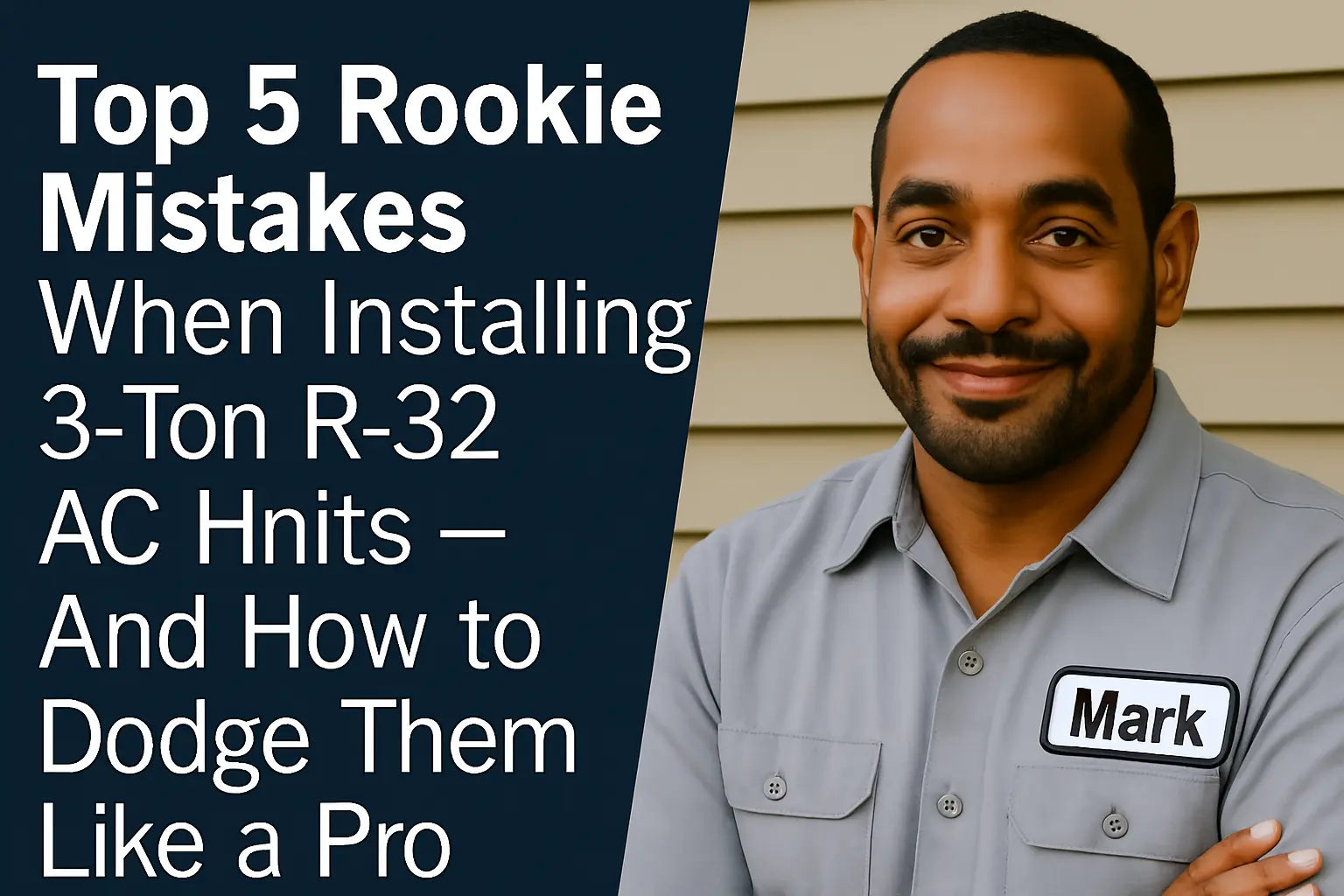🔥Mark’s Straight Talk Before You Touch That Toolbox
Hey, Mark here. If you’re about to install a 3-ton R‑32 AC system, first off, props for choosing a smart, efficient refrigerant that’s shaping the future of home cooling. But I’ve gotta say — I’ve seen plenty of folks, pros and DIYers alike, run headlong into traps that cost time, money, and a lot of frustration.
Installing an HVAC system isn’t like putting together furniture. It’s precise work. With R‑32’s mildly flammable status (A2L classification), safety is non-negotiable. Plus, a sloppy install can wreck your system’s efficiency, cut its lifespan, or even void warranties.
So let’s walk through the five most common mistakes I see with 3-ton R‑32 installs — and how you can avoid them. Get it right the first time, and your system will hum smoothly for years. Let’s get after it. 🧰❄️
1️⃣ Ignoring Proper Load Calculations and Oversizing the Unit
Many people jump straight to picking a 3-ton system just because their house “looks about that size” or they want to future-proof. But guess what? Oversizing is the #1 killer of HVAC efficiency.
When you pick a system too big, it cycles on and off too quickly (called short cycling). That stresses the compressor, reduces humidity control, and wastes energy.
The Department of Energy highlights how proper sizing increases comfort and lowers utility bills.
How to avoid:
-
Use a professional Manual J load calculation — it factors in your home’s square footage, insulation, windows, climate, and more.
-
If hiring a pro isn’t in the cards, use reputable online BTU calculators or consult with your equipment supplier.
-
Remember: a properly sized 3-ton system should roughly match a home of 1,500–2,100 square feet, depending on your local climate and home specifics.
2️⃣ Skimping on Electrical Setup and Wiring
Electrical mistakes can lead to costly failures or even fire hazards. The 3-ton R‑32 condenser requires a dedicated 230V circuit with a breaker rated exactly to the manufacturer’s specs.
Don’t guess amperage or reuse old circuits. The National Electrical Code (NEC) lays out clear standards for HVAC wiring.
Common slip-ups:
-
Using undersized wiring that overheats.
-
Improper grounding causing shorts.
-
Forgetting to install disconnect switches near the outdoor unit.
How to avoid:
-
Always hire or consult a certified electrician familiar with HVAC systems.
-
Verify wiring size, breaker rating, and grounding meet specs on your condenser’s data plate.
-
Install a weatherproof disconnect box within sight of the condenser.
3️⃣ Mishandling Refrigerant Lines and Charging
This is a biggie, especially with R‑32’s mildly flammable A2L classification. A leaky or improperly charged system won’t cool well and risks safety.
Typical mistakes:
-
Using old or incompatible line sets.
-
Loose or over-tightened flare fittings causing leaks.
-
Not pulling a deep enough vacuum, leaving moisture inside lines.
-
Charging by guesswork, not by weight.
The EPA’s Section 608 guidelines explain refrigerant handling best practices.
How to avoid:
-
Use manufacturer-approved copper line sets sized for your 3-ton R‑32 unit.
-
Deburr tubing before flaring; torque flare nuts to spec.
-
Use an electronic leak detector rated for A2L refrigerants to check fittings.
-
Pull vacuum below 500 microns to remove moisture and non-condensables.
-
Charge by the exact weight of refrigerant specified.
4️⃣ Neglecting Proper Placement and Clearance for the Outdoor Unit
Your condenser needs breathing room. If you cram it in a tight corner, under dense bushes, or on uneven ground, you’re asking for trouble.
Common issues:
-
Restricted airflow causing high head pressures and compressor strain.
-
Debris buildup leading to coil clogging.
-
Vibrations transmitting into the home causing noise.
How to avoid:
-
Place the unit on a level concrete or polymer pad elevated 2-3 inches above ground.
-
Ensure 24-36 inches clearance on all sides and at least 5 feet above the unit.
-
Avoid direct sun exposure where possible — shade reduces load and energy use.
-
Keep vegetation trimmed back regularly.
Check out the Air Conditioning Contractors of America (ACCA) installation standards for in-depth placement guidelines.
5️⃣ Skipping System Startup and Performance Testing
You’d be surprised how many installs end without verifying performance or safety. Startup testing catches issues early — saving time, money, and headaches.
Mistakes include:
-
Not leak-testing after charging.
-
Skipping voltage and amperage checks.
-
Ignoring superheat and subcooling measurements.
-
Starting up in extreme temperatures without proper procedures.
How to avoid:
-
Use an electronic leak detector and nitrogen for pressure testing.
-
Measure voltage and current against manufacturer specs with a clamp meter.
-
Calculate superheat and subcooling using gauges and temperature probes — HVAC School has great tutorials.
-
Follow manufacturer startup guidelines for temperature and airflow.
🧹 Bonus Tip: Keep Up With Maintenance from Day One
The best installs don’t mean squat if you neglect upkeep. Change filters regularly, keep the outdoor unit clean, and schedule annual professional tune-ups.
🔚 Mark’s Final Thoughts
Installing a 3-ton R‑32 AC system isn’t a weekend project to wing. The difference between a smooth install and a costly headache usually boils down to avoiding these rookie mistakes. Size right, wire right, charge right, place it right, and test it right.
If you’re buying or upgrading, I highly recommend checking out The Furnace Outlet’s 3-ton R‑32 residential AC collection. Their systems are engineered for modern efficiency, reliability, and come with great support.
Need some troubleshooting tips for your 3-ton R-32 AC system? Visit my guide: Keep It Cool.
And remember — don’t hesitate to bring in certified pros for anything electrical or refrigerant-related. Safety and comfort should always come first.
Stay sharp, stay safe, and keep those cool vibes flowing. I’ll catch you on the next one. 😎🧰
— Mark, your go to HVAC guide







